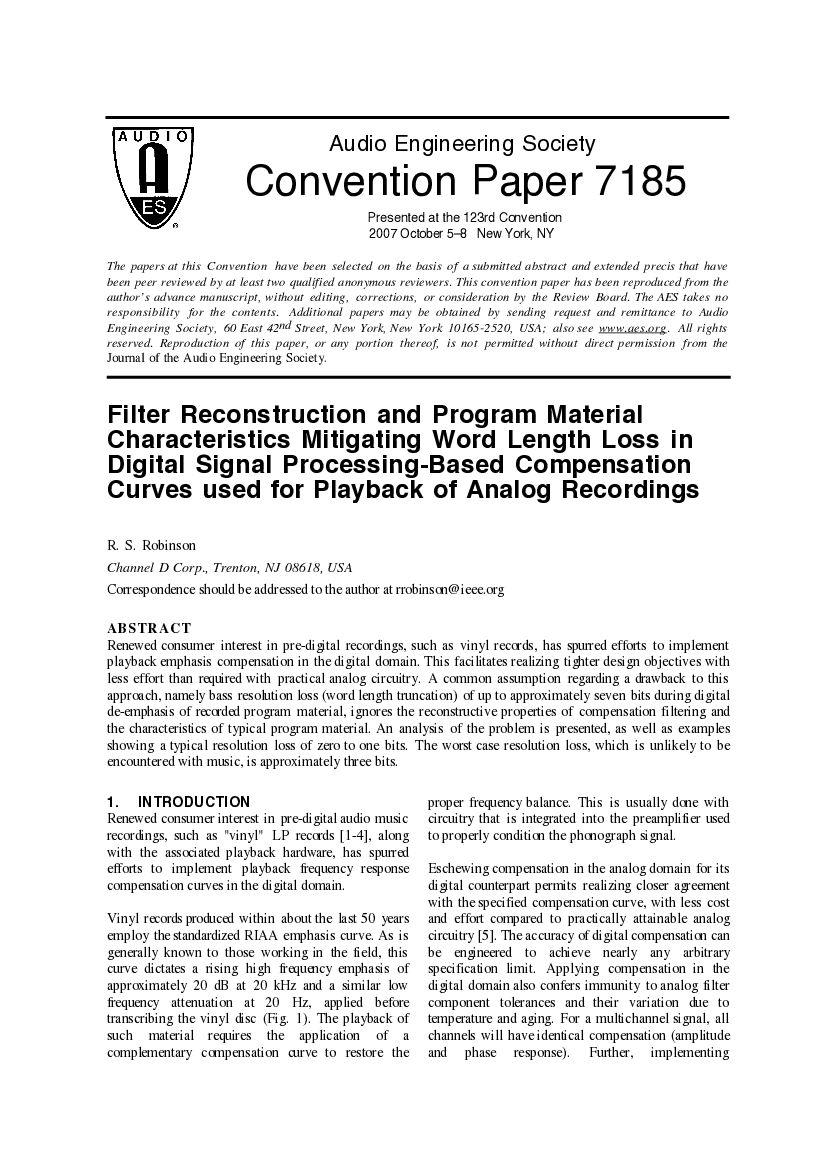Home / Publications / E-library page
You are currently logged in as an
Institutional Subscriber.
If you would like to logout,
please click on the button below.
Home / Publications / E-library page
Only AES members and Institutional Journal Subscribers can download
Renewed consumer interest in pre-digital recordings, such as vinyl records, has spurred efforts to implement playback emphasis compensation in the digital domain. This facilitates realizing tighter design objectives with less effort than required with practical analog circuitry. A common assumption regarding a drawback to this approach, namely bass resolution loss (word length truncation) of up to approximately seven bits during digital de-emphasis of recorded program material, ignores the reconstructive properties of compensation filtering and the characteristics of typical program material. An analysis of the problem is presented, as well as examples showing a typical resolution loss of zero to one bits. The worst case resolution loss, which is unlikely to be encountered with music, is approximately three bits.
Author (s): Robinson, Robert S.
Affiliation:
Channel D Corporation
(See document for exact affiliation information.)
AES Convention: 123
Paper Number:7185
Publication Date:
2007-10-06
Import into BibTeX
Session subject:
Signal Processing
Permalink: https://aes2.org/publications/elibrary-page/?id=14243
(495KB)
Click to purchase paper as a non-member or login as an AES member. If your company or school subscribes to the E-Library then switch to the institutional version. If you are not an AES member Join the AES. If you need to check your member status, login to the Member Portal.

Robinson, Robert S.; 2007; Filter Reconstruction and Program Material Characteristics Mitigating Word Length Loss in Digital Signal Processing-Based Compensation Curves Used for Playback of Analog Recordings [PDF]; Channel D Corporation; Paper 7185; Available from: https://aes2.org/publications/elibrary-page/?id=14243
Robinson, Robert S.; Filter Reconstruction and Program Material Characteristics Mitigating Word Length Loss in Digital Signal Processing-Based Compensation Curves Used for Playback of Analog Recordings [PDF]; Channel D Corporation; Paper 7185; 2007 Available: https://aes2.org/publications/elibrary-page/?id=14243
@article{robinson2007filter,
author={robinson robert s.},
journal={journal of the audio engineering society},
title={filter reconstruction and program material characteristics mitigating word length loss in digital signal processing-based compensation curves used for playback of analog recordings},
year={2007},
number={7185},
month={october},}
TY – paper
TI – Filter Reconstruction and Program Material Characteristics Mitigating Word Length Loss in Digital Signal Processing-Based Compensation Curves Used for Playback of Analog Recordings
AU – Robinson, Robert S.
PY – 2007
JO – Journal of the Audio Engineering Society
VL – 7185
Y1 – October 2007